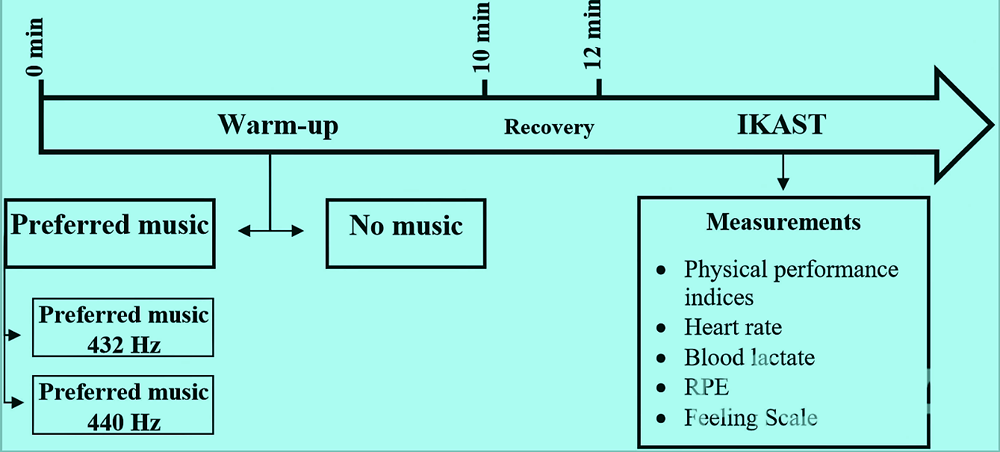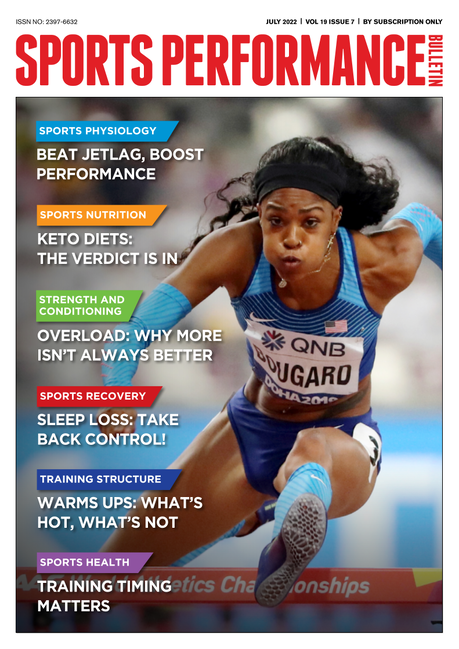You are viewing 1 of your 1 free articles. For unlimited access take a risk-free trial
Music to your ears: frequency matters for performance
SPB looks at fascinating new research showing that the musical pitch of the music you listen to can have a significant effect on your athletic performance!
Although only coming to prominence in the last 25 years or so, it was a researcher by the name of Dr Mark Anshel at Middle Tennessee State University who in 1978, first investigated the positive effects of music on athletic performance. Although his research passed largely unnoticed at the time, the topic really took off when sports psychologists starting researching why and how music can enhance performance - particularly when it comes to motivation and altering perceptions of fatigue - and which type of music is likely to be most effective. Now, it’s very commonplace to observe athletes wearing headphones in warm-up areas while they wait to compete!
What can music do for you?
Before we try and understand how music is able to exert the positive effects it often does, let’s clarify exactly what the performance benefits are. According to Dr Costas Karageorghis and Professor Andy Lane, two of the leading researchers into music and exercise (and both previous contributors to SPB), these benefits are as follows(1,2):
· Attention - Listening to music may be able to narrow the attention of the exerciser and as a consequence, this could divert attention away from feelings of tiredness and fatigue;
· Arousal - Listening to music has an influence on arousal states, and hence, in pre-competition situations, may be used to stimulate or calm down the performer;
· Synchronisation - Music has innate rhythmical qualities that we may respond to and which can make performing seem easier by allowing for the synchronisation and emulation of movement patterns to the music – eg keeping up a certain cadence on the bike;
· Mood state - Listening to music may be able to increase positive mood and decrease negative mood, thereby increasing motivation.
The natural questions that arise from the above are ‘how does music exert these effects’ and ‘what types of music will produce the most benefit’? This is where things get complicated as the research indicates it’s not a case of ‘one size fits all’(3). There are a number of factors that determine whether you will find a particular piece of music motivating; these include aspects of the music itself such as the lyrics, harmony and melody, and also personal factors, such as your socio-cultural background, associations of that music and of course, your personal preferences (see box 1). Research has shown that individuals often select completely different choices of songs or pieces of music, and if you’re a sports coach or exercise to music teacher choosing music for a class, it’s worth remembering that just because it works for you, it doesn’t mean that your exercise participants will automatically love it!
Box 1: The recipe for musical motivation
Professor Costas Karageorghis has proposed the following four key factors that can be used to determine how appropriate a particular piece of music for boosting performance:
- Rhythm response – rhythm has a major impact on the way we respond to music; a high-tempo rhythm is good for high-energy tasks while a slower rhythm is more suitable for low energy tasks.
- Musicality – refers to the harmony and melody in the song and how pleasing they are to your ear.
- Cultural factors - musical preference tends to be formed during adolescence and there are huge differences in personal preferences reflecting the age and background of listeners. For example, it’s not surprising that while Deep Purple might motivate a male 60-something, the preferences of a female 20-something are likely to be very different!
- Association – this relates to when you first became familiar with the music, the memories it evokes inside, whether you relate particularly to the artist(s) etc.
Individuality also plays a role in how susceptible we are to the motivational power of music. Studies carried out by Professor Lane on athletes’ susceptibility to music showed that some were much more influenced by music regardless of their individual preferences and backgrounds(4). In short, some people can’t help but rock ‘n roll when music’s turned up while others are either unaffected or prefer no music at all! Lane has produced a scoring system to determine how susceptible you are to the motivational powers of music (see table 1):
Table 1. Music mood regulation scale
|
|
Not at all |
A little |
Moderately |
Quite a bit |
Extremely |
|
If you need to feel relaxed, how effective is listening to music as a strategy to achieve this feeling? |
0 |
1 |
2 |
3 |
4 |
|
If you need to feel happy, how effective is listening to music as a strategy to achieve this feeling? |
0 |
1 |
2 |
3 |
4 |
|
If you need to feel energetic, how effective is listening to music as a strategy to achieve this feeling? |
0 |
1 |
2 |
3 |
4 |
|
If you are feeling worried, how effective is listening to music as a strategy to change this feeling? |
0 |
1 |
2 |
3 |
4 |
|
If you are feeling exhausted, how effective is listening to music as a strategy to change this feeling? |
0 |
1 |
2 |
3 |
4 |
|
If you are feeling downhearted, how effective is listening to music as a strategy to change this feeling? |
0 |
1 |
2 |
3 |
4 |
|
If you are feeling angry, how effective is listening to music as a strategy to change this feeling? |
0 |
1 |
2 |
3 |
4 |
The higher the total score, the more likely you are to respond positively to music as an ergogenic aid; score mainly 3s and 4s, and you’re susceptible. Score mainly 0s and 1s and you’re not very susceptible.
Musicality, frequency and performance
When it comes to the style/type of music most likely to improve performance, research has shown that a song with a high-tempo rhythm is more likely to be effective than something slower and more relaxed; studies have identified that for optimal effects, a fast tempo of 120 beats per minute or higher is recommended(5,6), and that the sound volume needs to be relatively high (80bB or higher)(7,8).
However, as mentioned above, one of the key ingredients in the recipe for performance-boosting potential is the musicality of the music being played – ie the melody and pitch (principle sound wave frequencies) of the song, and how pleasing it sounds to the listener. This is an aspect of music that is highly subjective of course, and the synergistic integration between frequency and rhythm of music remains unknown. However, when it comes just to the pitch of a song (ie the principle frequency to which the instruments are tuned), this is an area that has sparked interest over the past five years or so. In particular, music tuned to different frequencies such as 440Hz and 432Hz has attracted attention from researchers for its distinct positive effects on public health(9-11).
The frequency around 440Hz or the pitch of ‘A-440Hz’ has been accepted as a standard reference for tuning many musical instruments; research has established that music played on instruments at 440Hz with fast tempos and standards frequencies is perceived as crisp and clear, increasing concentration and intensity in workouts. This seems to occur by increasing heart rate and perceived exertion, especially during high-intensity training sessions(12,13). Meanwhile, music played on instruments tuned to 432Hz is generally considered more harmonious and relaxing, and has also begun to be introduced during recovery and mental preparation phases, with claims of reduced anxiety, and increased the mind-body connection(14). Just to be clear though, the difference in pitch between a song tuned to 440Hz and the same song tuned to 432Hz is only very slight – a pitch difference of just 1.8%. Listen to the short video clip below to get an idea for yourself!
New research on tuning frequency and performance
If music tuned to 440Hz or 432Hz elicits different responses in people, could the same song tuned to these different pitch frequencies also affect athletic performance, especially given the difference in pitch between 440Hz and 432Hz is just 1.8%? To date, this has never been investigated, but fascinating new research by a team of Tunisian researchers has come up with some answers(15). In this study, which was published in the journal ‘Peer J’, researchers investigated the effects of listening to preferred music tuned to different frequencies (440Hz vs. 432Hz) during a warm-up on specific physical performance parameters in kickboxing.
What they did
Fifteen men and thirteen women kickboxers took part in the trial. Following a standardized warm up, all the boxers performed the intermittent kickboxing anaerobic speed test known as ‘IKAST’. This test involves five repetitions of a combination of four techniques: (1) right-left punch, (2) right roundhouse kick, (3) right-right punch, and (4) left roundhouse kick. This sequence is performed over five sets with a 10-second rest between each set. The total execution time of the test is used as a validated measure of physical performance, as described by Gençoğlu et al in their 2023 research paper(16). The IKAST test was performed by all the kickboxers on three separate occasions 48 hours apart, each under a different condition (see figure 1):
· After listening to their preferred music around 440Hz during the warm-up.
· After listening to their preferred music around 432Hz during the warm-up.
· After performing the warm-up without music but while still wearing headphones (control condition).
Figure 1: Overall design of the study
Before these trials took place, the kickboxers’ music choices were sent to an audio engineer and tuned to either 440Hz or 432Hz using Audio Processing Object (APO) software that was able to change pitch. The ‘beats per minute’ count was also adjusted to a standard 140bpm. Importantly, the study design was a ‘double-blind crossover’ meaning that in the two music conditions, the kickboxers did not know whether their music had been tuned to 440Hz or 432Hz (the difference is very subtle and only detectable when the two pitches are played side by side!). The crossover condition meant that each kickboxer performed all three conditions - ie each athlete was able to serve as his/her own control.
The kickboxing-specific performance measurements taken included: the total time of sequences performed, the fastest sequence time performed (best repetition time) and fatigue index. The fatigue index, which indicated the relative decrease in power. Also, the highest speed of the best technical impact was determined by an analysis of video footage. In addition, a number of physical performance measures were made, including heart rate, blood lactate, rating of perceived exertion (RPE) and feeling scale (FS), which assessed the kickboxers’ mood states after testing.
What they found
The key finding to emerge was that compared to the control condition during the warm up, warming up with the 440Hz music allowed both men and women performed the IKAST significantly faster in the best time and total time indices with highest feeling scale (best mood) and lowest perceived exertion (see figure 2). In addition, the 440Hz music produced the highest impact velocity and lowest average heart rate during the test. Slight improvements were observed with the 432Hz music during the warm up, but these were too small to be considered significant. When broken down by sex, men had a lower heart rate with the 440Hz music warm-up while the women’s heart rates were lowest with the 432Hz music. In addition, women had higher positive feeling (mood) scale with PM440Hz, while men did not experience any significant change between the two musical conditions.
Figure 2: Time (seconds) to complete each repetition of the IKAST
A = all kickboxers combined; B = split by sex. Black line = control condition; light grey line = 432Hz music warm-up; Dark grey line = 440Hz music warm-up. Horizontal axis shows time in seconds to complete each of the five reps of the IKAST. Warming up with the 440Hz music produced significantly better performance across the board.
Implications for athletes
The results of this new research indicated that warming up with 440Hz tuned music resulted in the fastest IKAST performances compared with 432Hz tuned music and control (no music) conditions in both men and women kickboxers. That such a small change in pitch (that some people struggle to identify, even in a back-to-back demonstration) could elicit significant changes in performance is remarkable!
Why was music tuned to 440Hz better at enhancing performance than 432Hz tuned music? The researchers postulated that most musical compositions use a standard frequency of 440Hz as a tuning reference, and that kickboxers (like all athletes) are generally exposed from birth to music whose vibrations and harmonics are determined exclusively at 440Hz. This makes this frequency more “familiar” to them, and therefore best able to elicit an improvement in IKAST performance. By contrast, previous research has demonstrated that 432Hz tuned music can have a therapeutic effect when the goal is to reduce stress, anxiety and enhance sleep quality in patients with chronic diseases(17,18). Given that boosting attention and arousal is helpful for a high-intensity task such as the IKAST, it’s perhaps not surprising that the 440Hz music was superior to the relaxing 432Hz music!
In terms of practical application for athletes, it seems the pitch of your music does matter for performance. In the study above, 440Hz tuned music was superior to 432Hz for supporting performance. But is 440Hz-tuned music better for high-intensity performance than music tuned to other frequencies – eg 448Hz or 456Hz? The truth is, we don’t know. Anecdotally, some people have reported that listening to 448Hz tuned music is even more energizing than 440Hz-tuned (see the video below for a comparison of 432Hz vs. 440Hz vs. 448Hz tuned songs). And some very popular songs associated with ‘energy’ have used 448Hz tuning – for example Eminem’s ‘Lose Yourself’, Coldplay’s ‘Clock’ and Michael Jackson’s ‘Billy Jean’.
The good news is that many cheap audio software programs allow you to easily manipulate pitch, which is effectively the same as altering the tuning frequency. For example, to change a track tuned to 440Hz to 448Hz, all you need to do is add 8/440 = 1.82% to pitch speed. This gives you the option to experiment with your own preferred music; by increasing or decreasing pitch, you can see if it enhances the buzz you feel when listening. Don’t forget though, tempo is also important so you should try to aim for something fairly close to 140bpm whatever pitch it is. Having said all of this, if a tune is uplifting enough to your ears, you may not need to fiddle around with pitch. Just don your headphones and turn up the volume!
References
1. Psychol Bull. 2020 Feb;146(2):91-117
2. J Sports Sci. 2006 Aug;24(8):899-909
3. J Sports Sci 17, 713-24, 1999
4. Athletic Insight Volume 3, Issue 3, December 2001
5. Scand J Med Sci Sports. 2018;28(3):1166–1175
6. Journal of Human Kinetics. 2022;82(1):123–133
7. Perceptual and Motor Skills. 2023b;130(4):1644–1662
8. PLOS ONE. 2023a;18(4):e0284720
9. Explore. 2019;15(4):283–290
10. Music and Medicine. 2018;10(4):180–185
11. Evidence-Based Complementary and Alternative Medicine. 2024;2024(1):3006352
12. PLOS ONE. 2023a;18(4):e0284720
13. BMC Sports Science, Medicine and Rehabilitation. 2023a;15:21
14. Fauble L. Medicinal music: an anatomy of music in the healing arts. Prescott College; Ann Arbor: 2016
15. PeerJ. 2025 Mar 6;13:e19084
16. Research Quarterly for Exercise and Sport. 2023;94(3):715–724
17. Explore. 2019;15(4):283–290
18. Journal of Endodontics. 2016;42(9):1338–1343
Newsletter Sign Up
Testimonials
Dr. Alexandra Fandetti-Robin, Back & Body Chiropractic
Elspeth Cowell MSCh DpodM SRCh HCPC reg
William Hunter, Nuffield Health
Newsletter Sign Up
Coaches Testimonials
Dr. Alexandra Fandetti-Robin, Back & Body Chiropractic
Elspeth Cowell MSCh DpodM SRCh HCPC reg
William Hunter, Nuffield Health
Keep up with latest sports science research and apply it to maximize performance
Today you have the chance to join a group of athletes, and sports coaches/trainers who all have something special in common...
They use the latest research to improve performance for themselves and their clients - both athletes and sports teams - with help from global specialists in the fields of sports science, sports medicine and sports psychology.
They do this by reading Sports Performance Bulletin, an easy-to-digest but serious-minded journal dedicated to high performance sports. SPB offers a wealth of information and insight into the latest research, in an easily-accessible and understood format, along with a wealth of practical recommendations.
*includes 3 coaching manuals
Get Inspired
All the latest techniques and approaches
Sports Performance Bulletin helps dedicated endurance athletes improve their performance. Sense-checking the latest sports science research, and sourcing evidence and case studies to support findings, Sports Performance Bulletin turns proven insights into easily digestible practical advice. Supporting athletes, coaches and professionals who wish to ensure their guidance and programmes are kept right up to date and based on credible science.












